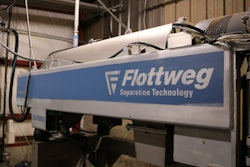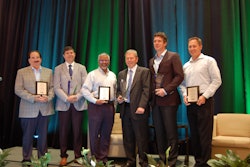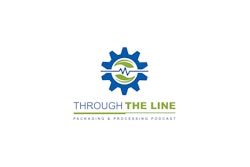Last October, global herb, spice, and flavor company McCormick & Co., based in Sparks, MD, released its 2017 Purpose-led Performance Report, which outlines the ways in which the company is embedding sustainability throughout its operations. This includes the strides it has made toward goals it set in 2015 for 2019, as well as new targets for 2025. All of its commitments are focused around three key areas: people, communities, and planet.
Listed under the “planet” category in the report is McCormick’s packaging goal for 2025: to reduce the carbon footprint of its packaging by 25%. In this exclusive interview, Michael Okoroafor, Vice President, Global Sustainability & Packaging Innovation for McCormick, talks about the company’s principles and goals around sustainability and the strategies it is using to meet these goals.
Packaging World: What is McCormick’s history in terms of its corporate social responsibility efforts?
Michael Okoroafor: When it comes to sustainability, it’s been in McCormick’s DNA for a long time. Our first report came out in 2013, but it wasn’t until early 2017 that corporate became more involved. We’re globally #1 in the food sector, as indicated by rankings such as Corporate Knights Top 100 Most Sustainable Corporations in 2016, but we always strive to do more. Now, with a new CEO [Lawrence Kurzius], we’re redefining ourselves. Both he and the company have a lot of passion around not just doing well, but doing good. Additionally, throughout McCormick’s 128-year history, we have been guided by a commitment to provide our customers, consumers, and employees with the highest-quality flavor products and solutions, with a responsibility to our people and the world around us. From our very first report in 2013, in charting our path forward, we have focused our efforts on clearly articulating who we are and what we stand for. To do that, we’ve defined our five guiding principles: Passion for Flavor, Power of People, Taste you Trust, Driven to Innovate, and Purpose-led Performance. These principles speak to our core values, and Purpose-led Performance is chief among them. By formally embedding this principle within our strategic roadmap, we have increased our commitment to make every day better, with responsibility to people, communities, and the planet.
PW: What are some of the drivers behind McCormick’s initiatives?
Okoroafor: We looked at our activities and after identifying four drivers, we wanted to take a more holistic approach. The first driver is community—not just where we live and work, but also in the communities where our products are sourced. Next is the consumer and the changing face of Millennials. For them, it’s about transparency, being able to access information about products. The third driver is our shareholders. It’s about our enduring supply chain; without it, we wouldn’t realize profits as a company. And the fourth is retailers. Walmart and others are looking at companies that are helping to build an enduring supply chain and impact the livelihoods in the communities where their products are sourced. Our 2015 CSR report included our 2019 goals, many of which we’ve already met or made great progress toward. In 2017, with our Purpose-led Performance Report, we laid out a series of commitments and clear performance targets for 2025. Our commitments represent a bold agenda for McCormick and will drive progress against the United Nations Sustainable Development Goals (SDGs). How important is it today for a major multinational brand owner to have a CSR strategy in place and publicly commit to goals around areas such as “people, communities, and the planet,” as in McCormick’s case? This is very important to McCormick, which is why we’re so focused on it. Additionally, one of the things that drove our PLP report and five principles is the UN SDGs, which gives a common yardstick for tracking sustainability goals in a holistic way for the first time. We believe all companies have an important role to play in driving progress against the UN SDGs and that sustained positive impact is only possible through multi-sectoral collaborations. This is why we have set ambitious targets and are committed to working with NGO partners, such as World Wildlife Fund and CARE, to map our strategy to achieve these goals.
PW: What does Purpose-led Performance mean, particularly as it relates to packaging?
Okoroafor: For us, Purpose-led Performance came from the core idea that it’s not enough for us to just do well as a company, we have to do good for our communities, people, and planet. Our new report incorporates a clear business strategy and alignment with the UN SDGs. We’ve done this work before, so we’re confident in our unwavering commitment to accomplishing our goals. Packaging is a key priority for McCormick. It plays a crucial role in helping us prevent food waste, guaranteeing our high-quality standards, and informing our consumers. It also helps us curb our resources and carbon footprint and contributes to other important objectives on our sustainability agenda, such as the elimination of BPA [Bisphenol A] from all of our packaging by the end of 2018.
PW: How do you establish realistic goals around reductions in your packaging footprint? What are your goals for 2025? How do they compare with your 2019 goals?
Okoroafor: We assess several external and internal factors when creating our goals, including but not limited to alignment with the UN SDGs; what our internal processes are and how we can improve them; and what our external suppliers’ processes are that affect our business—such as vendors, farmers, the supply chain—and how we can work with them to improve the processes. Our packaging goal for 2025 is to achieve a 25% reduction in the carbon footprint throughout the life cycle. In the past year, we have made updates to existing packaging to reduce our environmental impact based on the 2019 goals. One is the redesign of the iconic can for Old Bay seasoning and Black Pepper from tin to a fully recyclable PET container, which equated to a 16% reduction in associated carbon emissions. It’s also easier to use and keeps spices fresher for longer. Another is a 10% reduction in material for all European glass jars, resulting in reduced weight and associated carbon emissions from production and transport.
PW: How do you measure the carbon footprint of your packaging?
Okoroafor: In 2015, we talked about reducing the weight of our packaging; today we have adopted a holistic approach to reducing the carbon footprint across the entire value chain. That means looking at this globally. To measure the carbon footprint of our packaging, we use an industry standard, the Sustainable Packaging Coalition’s COMPASS Comparative Packaging Assessment Life Cycle Analysis design tool, which is informed by science.
PW: When looking at the design of packaging for a new product, or a redesign of existing packaging, how do you use the 4R framework?
Okoroafor: We take an integrated approach to reducing our environmental impact, and we meet these commitments through our 4R framework—Reduce, Reuse, Recycle, Renew. We apply this unified lens to everything. Because of its comprehensive nature, 4R helps us ensure that no material issues are left unattended. With a new package design, we will look at all four simultaneously. Design is an embedded aspect. If it’s an existing package, we can look at optimization while reducing the carbon footprint. 4R also helps us prioritize the issues most important to our business. For example, the generally “dry” nature of our products has led us to focus on water first—how to reduce its use and reuse or recycle any wastewater that results from our processes. As we move into more wet categories over the next year, including mustard and other condiments, we are keeping a keen eye on the potential need to renew and replenish the watersheds in which we operate.
PW: How do you select existing packaging, as in the example of Old Bay and McCormick Black Pepper, that are good candidates for redesign?
Okoroafor: Sustainable packaging design criteria are a part of our overall package design process. Our packaging designers and engineers are always on the lookout for ways to capture more environmental benefits. We prioritize packaging initiatives based upon those where we feel that we can make the greatest impact. Both the iconic Old Bay and the McCormick Black Pepper containers were made of tin and have high-volume numbers, so they were ideal candidates for a sustainable redesign.
PW: When it comes to packaging materials, are some favored over others? Why or why not? Are there any materials that McCormick will not use?
Okoroafor: We are material agnostic. At McCormick, we select packaging materials based on product requirements for safety, shelf life, and taste. Moving forward, we are eliminating the use of PVC and will not be making anything new that contains PVC in it. We’ve traditionally employed PVC in secondary packaging, such as shrink bands and not as primary packaging.
PW: At Heinz, you were involved with the transition to the use of Coca-Cola’s drop-in bioplastic technology for the company’s ketchup bottle. Is McCormick considering the use of bioplastics? Why or why not?
Okoroafor: McCormick is considering renewable materials, especially bio-based PET.Additionally, we are interested in other renewable plastic materials such as plant-based PE. We believe that there is value in looking at all materials, and we’re taking all into consideration.
PW: Are there any thought leaders or organizations in the sustainable packaging community that inspire you? If so, what have you learned from them?
Okoroafor: Paul Polman of Unilever has been an inspiration for my journey. We are looking at sustainability from the perspective of doing the right thing. Adopting a sustainable living agenda is quite motivating for me and the company.
PW: How—if at all—have you seen the concept of sustainability evolve as it relates to packaging? What do you see as some of the major trends in the near future?
Okoroafor: If I look at the last eight years, the concept of sustainability has changed in that people now have quantifiable ways of looking at things—people look at sustainability with a scientific approach. For example, the circular economy is evolving from the process of make, use, and dispose, to the more popular make, use, and reuse process. I believe that in our future, it is not impossible to visualize edible packaging as a component in our evolving landscape.
Packaging makeover preserves tradition, reduces footprint
McCormick’s Old Bay has been a food-seasoning staple for more than 75 years, with its familiar blue-and-yellow tin package achieving iconic status as well. The same can also be said of its red-and-white Black Pepper tin. But with McCormick’s aggressive environmental goals around packaging, including reducing the carbon footprint of its packaging by 25% by 2025, the company felt it was time for a change. The switch—from a tin container to one made of PET—was skillfully executed however to retain the brand equity of the original, while reducing CO2 emissions by 16%. According to Michael Okoroafor, Global Sustainability & Packaging Innovation for McCormick, two factors spurred the redesign: “The idea of eliminating the inside coating that contained BPA and enhancing our carbon footprint stimulated our approach. When you look at the energy needed to recycle metal versus PET, metal requires a significantly higher temperature—over 1,000 degrees Fahrenheit for metal versus about 400 degrees Fahrenheit for PET. It made sense that we would look at both at the same time.” McCormick began working on the redesign in the mid-2000s, but ramped up development over the last three years after committing to eliminating all BPA from its packaging by year-end 2018. From the beginning, the company had its eye on PET due to its proven sustainable nature, which includes 100% recyclability, Okoroafor explains.
The task of making the switch to PET while maintaining the appearance of the original package presented some challenges, Okoroafor admits. “So we leveraged creative partners and technical houses to address areas of weakness, which enabled us to arrive at an optimal design,” he says. With the redesign, McCormick also took the opportunity to add a freshness seal as well as make changes to the lid to allow for easier measuring and pouring. The opening of the package is now covered with a tamper-evident lidding film that, when coupled with the PET container, increases the shelf life of the product inside. Explains Okoroafor, “Metal packaging is vulnerable to egress of moisture and volatiles. We eliminated that by going to a PET format with a tamper-evident seal.” The new lid, the design of which was based on consumer input, is a multifunction closure that allows consumers to sift, pour, or spoon product. The Old Bay and Black Pepper packages are decorated with oriented polystyrene sleeve labels that stay true to the graphics of the former package. The new containers were introduced on shelves in fall 2017. While Okoroafor says the new packaging has led to cost savings for McCormick, he can’t share specifics.
Euro jars: a weighty challenge
One of McCormick’s considerations in choosing a package that can be redesigned for greater sustainability is how great an impact the change will have on the carbon footprint of its packaging. Therefore, the sheer volume of packaging represented by its Euro jar glass jars—used for all its herb and spice products in Europe as well as for some in China and Australia—made them an ideal candidate for a change. Europeans are wedded to their glass jars, so a switch to PET was not an option. But lightweighting the packaging was.
The challenge was to take material out of the jars while eliminating breakage during the manufacturing process. “The glass breaks primarily due to the residual stress during the annealing process,” explains Michael Okoroafor, Global Sustainability & Packaging Innovation for McCormick. “By FEA [Finite Element Analysis], we could see where the stresses were to minimize breakage.” Each jar shape and size had to analyzed individually.
For this project, McCormick worked with Agr Intl., which Okoroafor says is known around the world as having the best capability for glass research. “We are not experts in glassmaking,” he says. “We worked with Agr to optimize every aspect—it was pure collaboration. After we did that, we brought it to our glass suppliers and advised them on how to implement the changes. We are continuing the process of lightweighting globally.”
The new jars began rolling out in 2017, resulting in a 10.4% reduction in carbon emissions versus the previous package design.






















